This is the adapted text of the keynote talk given by Philip Gross, poet in residence at the Poetry on the Move festival at the University of Canberra 2015.
Keywords: poetry—collaboration
Somewhere near the heart of creative writing is an experience most of us have felt in action, though maybe not named, still less seen as a deliberate strategy. Indeed, trying to have it on purpose might even seem impossible, counter-productive, in some sense wrong. The experience I mean is when something you’re writing lifts off—is lifted, in the sense of a bird that catches the feel of a thermal in its wings. It is the air that lifts, not the hawk, though the bird has to be ready, and to use the judgement of its instincts, brilliantly. (I’m not saying that this experience is a guarantee of brilliant writing. It is more everyday than that. It may be a part of any small creative train of thought, however mundane.)
But the feeling is one that most writers are moved by, and desire. For that reason, it has bred mythical thoughts to account for it, like ‘inspiration’ or ‘the muse’. At best, of course, we’re not thinking at all—or not thinking about, simply doing it. But if we attend a creative writing symposium at a university, or read an article like this, it is presumably because we are in some sense thinking writers, and thinkers about writing too. We trust that genuine creative process isn’t such a shy beast that it slips into the undergrowth at the first hint of a thought.
Even so, how to catch a sight of that shift, of that lift in the air? I hope to be practical about this, both as writing habit and as pedagogy—and to suggest that one way to observe that fleeting un-thought thing in action is collaboration. Then, it has to cross the space between two people (two or more). On the way over, its trace might be seen.
Flashback to 1969... I’m in my friend Pete’s garage, with our rock band. (No, you won’t have heard of them, though our name, Waste Land, hints that literary references were never far away.) We were not great. But now and then, and mostly when no one was looking, a small great thing happened.
And beyond
words, just once in a while in a night in a daze of forgetting
our scarcely a music lesson’s notes to scrape together,
we’d play, climbing on each other’s shoulders, stepping
off as an updraught caught us and we didn’t fall, we flew.
(Gross 2003: 47)
That was improvisation, and it meant collaboration. The experience, the physical sensation even, was of finding ourselves, each of us individually, doing something better than any one of us alone could do. For the solitary writer, too, that click into place of a new perception, that lift, is the same sensation: blink, did I do that? Yes and no. Something did.
It might seem a long way from this metaphor of flying to the mass and bulk of stone, but I have grown to trust a good creative paradox when it taps me on the shoulder. The next time I felt that particular lift was with the megaliths of Stonehenge—in particular its famous trilithons.
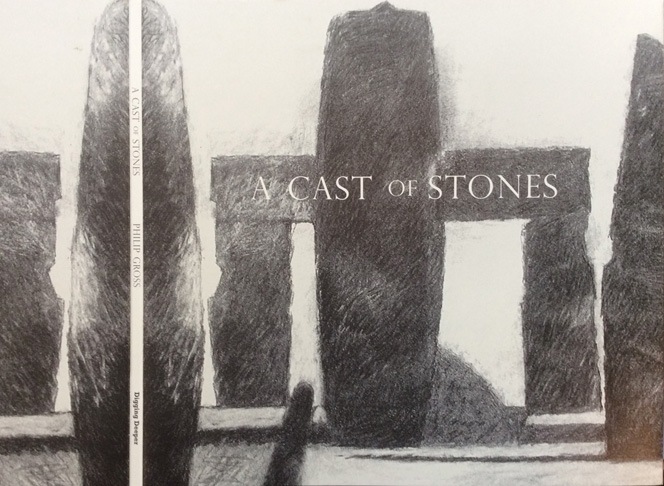
A game of Henge, my masters?
The pieces are set. We lost the box
with the instructions years ago.
Do you see Hangman? Or
Clock Patience? Building bricks
the gods grew out of? Dominoes?
It’s your move. You’re in the ring
of the hills, of the stones, of the walls
of your skull. You want to go?
You want out? Good - that’s
the game. Whichever way you turn
are doors. Choose. Step through, so...
And whichever world you stumble into
will be different from all the others, only
what they might have been,
you’ll never know.
(Gross, Eaves & Kennedy 1996: n.pag.)
I wasn’t actually among the stones, in fact. No member of the public is allowed that close today. These were drawn images of Stonehenge. Nor was this poem, the first in a sequence called ‘A Game of Henge’, to do with the stones as much as the spaces between them—and the vistas, all the possibilities, that those apparent gateway-shapes might open into.
It was my first deliberate collaboration with an artist. In the early 90s I was drawn into a free-form music/art group with five or six people from several traditions - classical orchestral music, jazz and folk - who had gathered around a painter called John Eaves. The rules of the game were that people left their different trainings at the door, came in and improvised. At one event, the performance space was surrounded by John’s monumentally large, slightly abstracted charcoal drawings of Stonehenge. We were inside the circle. The stones themselves were not explicit. The fascination of Stonehenge itself is that a site so plainly full of meanings has never been pinned down (and long may this last) to any one meaning we can know.
For the musicians, and for the writer who stepped into that charged space, this not-knowing was the enabling and creative thing.
Even not-knowing is contingent and specific. The poems that developed from our work (our play) together were not descriptions of the stones, but they were conditioned by them, by each other... and especially by the spaces between. When those poems finally appeared in print, it was in a volume shared with another sequence and another artist. I met the painter FJ Kennedy for one day, to explore the other great megalithic complex of southern England, Avebury. The site is miles wide, and we walked. When her painting started to emerge, they were sensuous, highly coloured, with lines always in motion - a complete contrast to the monumental monochrome of John Eaves’ Stonehenge. The poems that came to inhabit them were narrative, shot through with gender and a hint of dalliance, but with a quality of journey, too. Within the covers of one book, about so similar a subject, very different work grew from a different space-between.
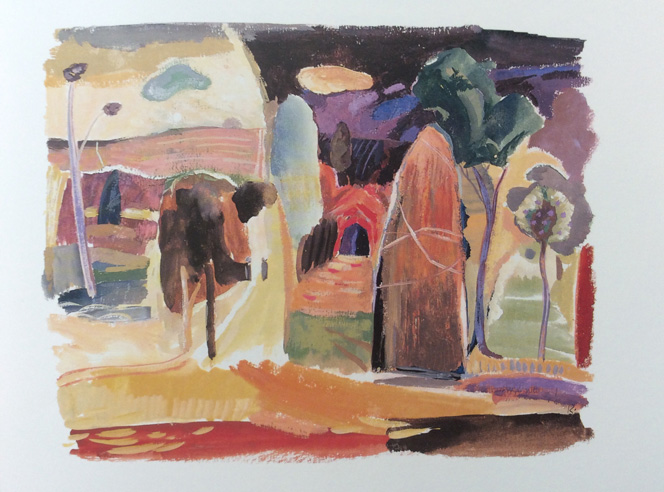
I know writers who shudder at the word ‘collaboration’. Cue for the joke about a camel being a horse designed by a committee. When I mentioned the word to an early and prestigious publisher of my work, their response was, anxiously, ‘But whose name will come first on the title page?’ Poets are famously concerned with finding, owning and promoting their own voice - though what that ‘voice’ means could be another whole hour’s talk.
There is fear in this too. Since Harold Bloom’s (1973) Freudian-critical study of the same name coined the phrase ‘anxiety of influence’, the fear of losing or never finding our unique poetic selves in our relationship with more powerful others has been widely taken as a fact of writing life. There is support for this kind of individualism in Romantic attitudes to creativity, but Shakespeare knew better. Theatre, where he was at home, was necessarily and always a collaborative medium - whoever’s name appears on the First Folio. Even his sonnets are an interplay with, sometimes a teasing of, the tropes and conventions of his time.
Writing in any field and domain, any genre, is collaboration of a kind - and so is writing in implicit or explicit conversation with another writer, long dead or alive. Any time we write in a poetic form we are stepping into a charged space, shaped in advance, with particular energies available. We are not alone.
On Poetic Form: A Short Essay
The form stands in the corner of the room
like a man made of glass. All he can be
is how the light bends through him; he’s the way
reflections and refractions play, the zero sum
of its deflections and distractions. Come
on in, I say, as if there was a he
to speak to, or an I to speak, or words to say
or any other place to come in from
except time. How many rooms have held, might hold
him, he them - had their decor rearranged
in his impartial gaze? He makes me feel old
and young (not in a good way) and yet… Chance
it, he says, silently, and everything is changed.
He never moves, and yet we start to dance.
(Gross 2014: 10)
It would be an easy step to theorise that all creative work is collaboration, but let’s not lose the practical first hand points in abstractions. I am trying to trace specific instances of the process in action—times made visible because in collaboration the spark has to pass across the space between us. However momentary this is, it leaves a trace.
In the case of my first collaboration with another writer, poet Sylvia Kantaris, the traces were made in the post. This was before the days of e-mail. The slowness of post was a factor; the two hundred miles from Bristol to Cornwall was also a distance of days, a palpable space between us. The first spark of the book came from much further away—a postcard from Sylvia’s son in the foothills of the Andes. Conditioned partly by his reading of South American magic-realist fiction, he offered the whim of the phrase that ended up as the title of our book, The Air Mines of Mistila (Gross & Kantaris 1998). That elusive and substanceless no-place crystallised from a stray invention on my side, to which another of Sylvia’s responded and so back and forth until the fictional Mistila became a manifestation of the space-between, a space each of us entered again and again, always leaving our trace. Our starting points and styles and interests were different, and it quickly became clear that our different genders would become a generative issue too, poetically.
If email had been our medium then, several poems might have passed back and forth each day. As it was, each of us would often receive a letter over breakfast, and get an answering poem back in the post by midday. Even so, at the height of the work the genuinely uncanny happened, with the two of us ‘discovering’ the same thing or new character independently, or answering questions which would be asked by the other in a letter that had not reached us yet. As with children playing with a ouija board, each of us trusted and enjoyed the fact that surely the other one was steering it, until the end when we looked at each other and both said, ‘But I thought it was you!’
The point to assert about good collaboration - and by ‘good’ I mean creative, enhancing the richness and the range of possibilities - is that it takes nothing away from either party: by trusting the momentum of the work, you become more, not less of yourself. What the work discovers, as it evolves, are aspects of you as a writer that you may not be aware of yet. Whatever happens to the shared work, this is yours to keep.
The collaboration I am talking about here is distinct from the kind, often honourably led by political priorities, that deliberately disavows individual ownership and authorship. True, my own experience is that letting go of sole control may unlock a work’s potential to be itself. But mainly I am thinking of people who come on writing courses, people not unlike myself, who want the thrill of that relationship between them and the poem. Or, let’s be honest, who quite like to see their name on it when it enters the world. For those people too, collaboration at best is a win-win game, in which both parties go away with a gain.
At worst, of course, collaboration can be all people fear - a compromise, less than the sum of its parts, just as good collaboration becomes more. At all times, though, collaboration poses healthy questions for the writing ego, both for the starting and the experienced writer, the under- and the over-confident. For some beginners with no set sense of themselves yet as writers, it can be a liberation. They have nothing to lose. And the most confident, if theirs is a deep and easy confidence, can trust to the principle of play. Brittle confidence is what gets tested—and this is valuable learning too, learning that needs careful holding. In a group situation, it needs leadership with pedagogic skills.
No one can guarantee to make that difference between productive and inert collaboration, and any real creative work will sometimes fail. I suggest, though, that having a way to conceive of a collaboration with a life of its own, as active space the partners hold between them, helps create the trust and the shared understanding it needs. This may be mythical thinking—in other words, a metaphor that shapes the way we live - but if it shapes the best conditions for the shared work to succeed, it is in some sense true.
The realisation that this personal preference of mine could be useful pedagogy grew out of working with people of all ages—courses first of all in poetry, then in poetry and art, for adults and for children. The trope of the poem as box, containing items embodying experience or feeling, has been a valuable part of the shared culture of creative writing with young people in the UK for many years, most memorably realised by Kit Wright (2009). To make it a shared box, created by one partner to be filled by another, is a logical development. The imaginary box enacts a relationship; it becomes a figure of that collaborative space-between. One partner might propose:
Item: clearly, a strongbox,
dented metal, strapped and braced -
not one right angle or one straight edge -
beaten out of shape by life but never burst.
Inside...
A pause here, while the poem changes hands... The other writer answers:
if you could ever find the key
will be a brittle powder-blue
blown bird’s egg, and a note beginning
Dear, I found this, and I thought of you…
(Gross 2010: 15)
That box, in fact, was more than metaphor. It took physical form, on one of a series of cross-arts courses held with school children between ages 9 and 13 on the Isle of Wight (Gross, Fulleylove & Gross 2006: 18–26). That alerts us to the way collaboration can pass not just between writers but across the distance between art forms. When it does, the traces of the process become even more visible, as each of you has to make ‘translations’ from your own aesthetic language to someone else’s, to communicate.
The Abstract Garden, a fine press book made with the late engraver Peter Reddick, was my first decision to collaborate from scratch. The artist and I already knew each other and each other’s work, liked the idea of collaboration and were waiting for a pretext to begin. This came in the form of an invitation from The Old Stile Press. To put it another way, the press created a particular arena in which we would meet, one practically embodied by the fact that the publisher and printer, Nicolas McDowall, would be book designer, a third party in the collaboration. His medium was literally the space between, and both artist and writer could relish the ways we saw our own work releasing different meanings as our ‘spaceman’ experimented with first this, then that, layout on the page.
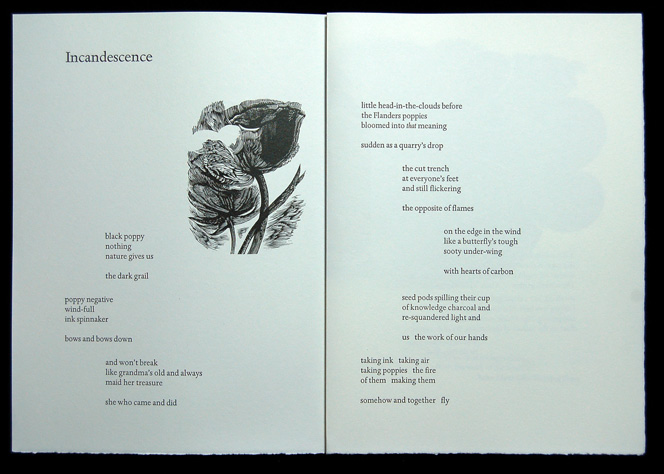
The word, the image, and the space between…
Like prints that trail off in a swirl of snow
what’s meant is more than it was meant to mean
- by us, at least. ‘Be-hind you!’ The unseen
is always creeping up to steal the show.
The word, the image, and the space between
are buddies, lovers, rivals in a teen-
soap romance: boy next door or gigolo?
What’s meant is more than it was meant to mean:
three dots, for instance, when the slick machine
of language stalls, a glimpse of depths below
the word, the image, and… The space between.
Old songs: ‘I saw the young moon yestere’en,
the old moon in her lap.’ Words like afar… ago…
What’s meant is more than. ‘It was meant.’ To mean
is human; to reveal, divine - a clean
break into…
What’s that? Oh,
the Word? The Image? And space, space... Between
what’s meant is more than it was meant to mean.
(Gross & Reddick 2006: n. pag.)
This is of course a villanelle, a form that could have been designed as a collaborative space. It certainly adapts to being one, as a creative exercise in form and response. The dynamics of the poem are created by a shifting relationship between the first and third lines of stanza 1. Ask a friend to give you a line 3 to be rhyme-partner to your line 1. Their line comes unasked, and you have six stanzas to work through the changes, to the point where they can stand together in the final verse. On the way, all those line 2s are literally the space between them, across which their relationship is played out.
In creating The Abstract Garden, the space between the word and image became tighter, though the differences between the parties no less distinct. We moved from simple response to finished work, each to the other, into a more trusting rapport in which either could find a fragment or even a reject in each other’s note- or sketch-book, and respond. Often this led to the fragment being developed, or the reject restored, in ways the first maker could not have predicted. We were getting not only inside each other’s work, but inside its making, which is one step more intimate.
Indeed, it soon became clear that the most potent stimuli tended to be the unmade, the unfinished marks or pieces, rather than those buttoned up and self-complete. The spaces in them, like the gaps between the Stonehenge megaliths, were ones into which the other art form could naturally step.
That project was the closest I had come to Vera John-Steiner’s (2000) concept of integrative collaboration—as opposed to co-operation in discrete activities, or the intermediate distributed collaboration where roles are shared out, demarcated. John-Steiner’s prime example of the integrative type is the Cubist moment when briefly Picasso and Braque produced new work more similar to each other in its own emerging style than to either of their previous works.
It might have seemed a step back, then, to a next collaboration, I Spy Pinhole Eye (Gross & Denison 2009), with photographer Simon Denison, in that his work was done first. He came to me with a large body of photographs on the most apparently un-alluring subject—unretouched pinhole camera images of the concrete footings of electricity pylons. They were all the same and, once you stopped to look with the patience of that unbiased camera, all quite different. It was this dogged, meditative insistence on fixed point of the image that prompted poetry, in an even more intense way than the stones of Avebury or Stonehenge had done. A whole book-full of fourteen lines poems (yes, inevitably in their own conversation with the sonnet) circled round the thing that resists description, and so provokes response.
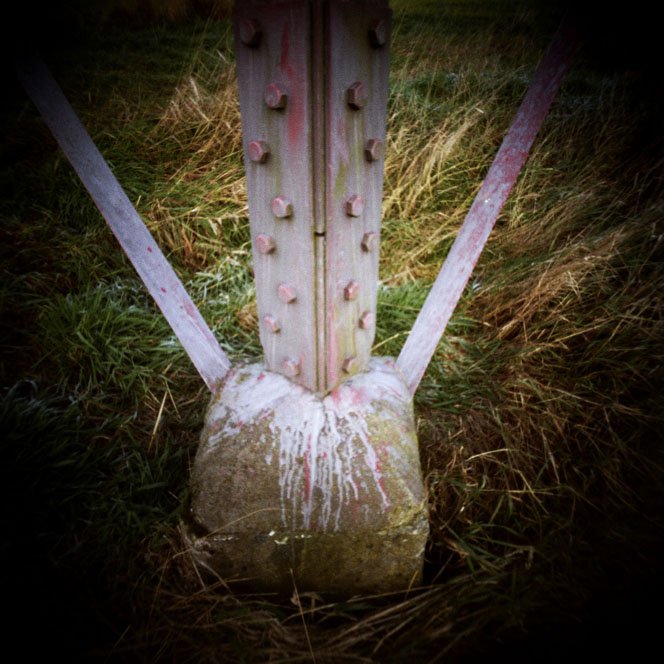
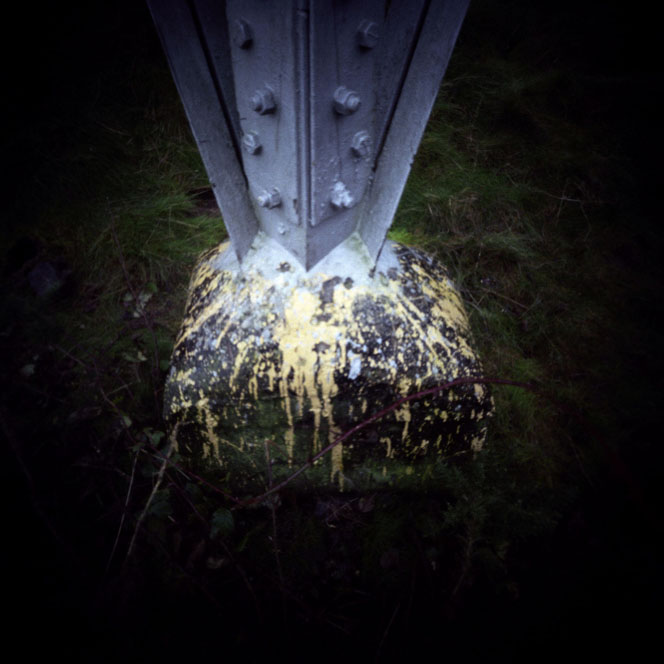
The final pay-off, for me, was the photographer’s comment that not only were the poems comments on, or fantasias around, the photographer’s process, but that somehow the images had been ‘changed’ by them. This is no stranger a claim than mine that the poems and engravings in The Abstract Garden had been changed by the way they were disposed round the space on the page.
The cross-arts connection feels important as a glimpse into collaborative working. The examples I have mentioned do not feel like ekphrasis, to me. The point is never for the words to restate, or to write a gloss upon, the picture, any more than the images are there to illustrate the words. The principles behind their meeting are of mutuality and equality... and also of difference. As a way of figuring the creative space between them, I come back to my own experience of Quaker meetings. The main shared activity there is simply, and together, to hold the quiet space between the people. Words might or might not occur in it, but the main activity is listening. Though the experience is sometimes described as being ‘gathered’, with an implication of like-mindedness, it does not depend on unanimity. In fact, this would reduce its power. Rather, all present are equally committed to the possibility that some new insight, owned by none of us, might emerge from the space between us—especially so in the light of the fact that we are different people. Not invariably but often, so it does.
With apologies to Charles Babbage, early father of computers, I would like to borrow the term he used for his machine: the difference engine. Cross arts collaboration is a difference engine, as is working with another writer when each of you is trusting enough to be distinct and open to each other. (So, maybe, is any good relationship.) The difference, held across the space between you, gives that space its energy, and shape. The same creative principle that applies not only just between people but, by Keats’ principle of Negative Capability (1817), the ability to embrace uncertainties and contradictions to positive and creative effect, it applies within each of us too.
This sense of collaboration goes beyond writers working with creative artists. On a recent interdisciplinary project (Dillon et al. 2013: 100–126), of the kind increasingly encouraged in the academic world, I found myself working with a visual artist and with an environmental biologist, a cultural ecologist and a natural resources economist.
This led to further work between myself and the artist, Valerie Coffin Price, in a process closer still to John-Steiner’s integrative collaboration—again, getting inside each other’s process, with words leaking over to be broken up and used as a part of the art work and in turn reflecting on the process of making the art, while the artist found herself sometimes writing poems, and I made free with the materials in her studio, making images that were and weren’t my own.
The title of the resulting book, A Fold in the River, referred to specific location on the River Taff in South Wales, but equally to the Chinese- or Japanese-style folding notebook Valerie used for her work. Its creases were, intentionally, still visible in the final printed version, and the form offered one more way in which the shifting space between the different arts and individuals can coexist, at the same time both together and separate.
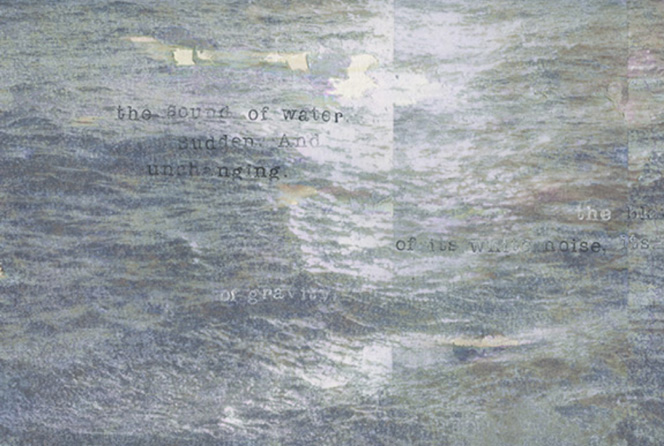

On mulberry paper as fine as closed eyelids,
in ink made of soot and glue, the nested scroll
could open this way, that or both, each unknown
to the other. Or could leave it sleeping, fold on fold.
(Gross & Coffin Price 2015: 21)
It is maybe the characteristic of this kind of thinking that it begins by referring to one very specific writerly experience, and comes to offer itself to almost any aspect of how we relate. It certainly proposes itself as an image for creative writing teaching, in particular the time-honoured, maybe taken-for-granted tool of the discipline, the writers’ workshop. Many educators have suggested it is time to re-conceive or at least to revisit the workshop principle. The practice has the whole range of affordances that human beings have: unawarely used, it can be limiting, conformist, condescending or destructively combative... while with skilful holding and nurturing, it can be a vivid co-creative space. That word ‘space’ asks to be seen in just the sense this talk has used it—collaboratively held, allowing a disciplined release of individual ownership, and liable to return to the writer a work-in-progress that is more itself, not less. This happens not because a leader or any individual member of the workshop has the best idea, but because the space itself permits it, as if with a life of its own.
... much as this
rippling shiftless shift
of interference patterns, con-
-versation, moves
of itself, without moving, as
silk flows, its waves
of moiré, something of
us and between us, made of
you and me, yet neither me nor you.
(Gross & Coffin Price 2015: 55)
Finally, I am left with that well-known optical trick sometimes known as Rubin’s Vase: two silhouetted profiles facing each other... or you blink, and it is a vase or candlestick. Blink again, and they’re two faces. Is this merely an illusion? I would say not; it is an illustration of the independent life of space-between. Let me end on a poem that must be to do with relationship, because it is a love poem, though it lets itself get led or lifted into agnostic theology. At the same time it strikes me as entirely down to earth, to do with this business of writing that we practice and we teach.
And whatever
has to be
left or to leave us
including our selves
this space
we form between us
(flexing
fringed with our skin’s warmth
round the edges
sometimes
rippled with one voice or
the other sometimes not)
still
is
: an astonishment
that somehow
I believe
will stand for us before
God
who equally
(much like it) may be
(but more so) no
thing
no this and no that
but living
space
between
(Gross: unpublished)
Bloom, H 1973 The Anxiety of Influence: a Theory of Poetry, New York: Oxford University Press
Dillon, P, Gross, P, Irvine, R, Coffin Price, V and Staddon, C 2013 ‘Thinking like a wetland’, Journal of Arts and Communities 4 (1–2), 100–126
Gross, P 2003 Mappa Mundi, Tarset: Bloodaxe
Gross, P 2014 'On Poetic Form: A Short Essay', Poetry Review 104 (2), 10
Gross, P and Kantaris, S 1988 The Air Mines of Mistila, Tarset: Bloodaxe
Gross, P 2010 Off Road to Everywhere, Cambridge: Salt
Gross P and Coffin Price V 2015 A Fold in the River, Bridgend: Seren Books
Gross, P and Denison S 2009 I Spy Pinhole Eye, Blaenau Ffestiniog: Cinnamon Press
Gross, P, Eaves, J and Kennedy F J, 1996 A Cast of Stones, Avebury: Digging Deeper
Gross, P, Fulleylove, L and Gross, Z 2006 ‘No Artform Is An Island’, Writing in Education 40, 18–26
Gross, P and Reddick, P 2006 The Abstract Garden, Llandogo: Old Stile Press
John-Steiner, V. 2000 Creative Collaboration, New York: Oxford University Press
Keats, J. Letter to George and Thomas Keats, 21 December 1817
Wright, K 2009 The Magic Box: Poems for Children, London: Pan Macmillan